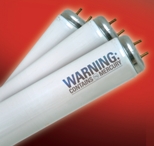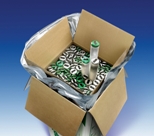
Easing the Risks from Broken Fluorescent Lamps
Better packaging standards would provide protection from mercury vapor emissions from this source.
- By Brad J. Buscher
- Sep 01, 2009
Fluorescent lighting has long been recognized for its energy savings benefits. Economic factors, such as rising energy costs, coupled with increased consumer environmental awareness over such issues as global warming, have pushed this lighting source to the national forefront. Fluorescent lamps give off the same amount of light as their traditional incandescent counterparts, but they require considerably less electricity, which in turn reduces the damaging effects electric power generation causes to the environment. The lamps also provide significantly longer working lives. Because broken fluorescent lamps emit mercury vapor if accidentally broken, the benefits allotted by fluorescent lamps don't come without potential risks if appropriate precautions aren't taken.
 Shipping, packaging, and handling of fluorescent lamps is a major concern because of the harmful mercury vapor emitted when the lamps are broken, which commonly occurs during shipment. To lessen the health and environmental risks associated with mercury vapor, national laws -- sometimes supplemented by more rigorous state laws -- exist to encourage proper recycling of fluorescent lamps. EPA encourages recycling of these lamps by allowing common carrier shipment to recycling facilities. To protect people who handle fluorescent lamps, EPA instructs that packaging should be designed to protect against breakage. While the rules mandate that lamps be packaged in structurally sound packages, the federal laws don't explicitly address mercury vapor release.
Shipping, packaging, and handling of fluorescent lamps is a major concern because of the harmful mercury vapor emitted when the lamps are broken, which commonly occurs during shipment. To lessen the health and environmental risks associated with mercury vapor, national laws -- sometimes supplemented by more rigorous state laws -- exist to encourage proper recycling of fluorescent lamps. EPA encourages recycling of these lamps by allowing common carrier shipment to recycling facilities. To protect people who handle fluorescent lamps, EPA instructs that packaging should be designed to protect against breakage. While the rules mandate that lamps be packaged in structurally sound packages, the federal laws don't explicitly address mercury vapor release.
In 2005, EPA added a requirement that packaging for "mercury containing equipment" be designed to prevent mercury from escaping into the environment. Fluorescent lamps aren't currently included in this rule, however. While the national government doesn't require fluorescent light packaging to prevent mercury vapor release, several states have addressed this health issue with their own, more specific regulations regarding fluorescent lamp disposal. Minnesota, Massachusetts, California, and Vermont are among states that prohibit disposal of all mercury-product waste in landfills. New York has a similar ban, with an exemption for households and businesses with 100 or fewer employees disposing of 15 or fewer non-hazardous waste lamps per month. Many other states prohibit non-household generators from disposing any mercury-containing fluorescent lamp in solid waste landfills, regardless of TCLP test results; these include Connecticut, Maine, New Hampshire, Florida, and Rhode Island.1
OSHA has set a mercury permissible exposure limit (PEL) of 0.1 mg/m3 (8-hour time-weighted average).2 Many health experts and some states suggest the federal limit is too high and suggest a stricter mercury vapor limit mercury of 0.05 mg/m3 (8-hour TWA). Additionally, the American Conference of Governmental Industrial Hygienists recommends an even lower threshold limit value (TLV; 8-hour TWA) of 0.025 mg/m3, which has been adopted as the standard for California.3
A recent fluorescent lamp packaging study was conducted by the University of Minnesota School of Public Health's Division of Environmental Health Sciences. Results of the study indicated that, upon breakage of fluorescent lamps contained within commonly used package designs, just one out of the five packaging configurations tested in the study minimized hazardous mercury vapor exposure levels to below all three acceptable occupational limits, as defined by state and federal regulations and guidelines.
Results from the study indicate that upon breakage, mercury vapor concentrations could exceed occupational exposure levels when working with or near broken bulbs, especially when multiple bulbs are stored or shipped in bulk to recycling facilities. In other words, packages that aren't properly designed to contain mercury vapor represent a genuine health and safety risk. According to the study, the packages that don't provide high levels of protection against mercury vapor emissions include a single cardboard box; single box with an unsealed thin plastic liner; single box with a thicker, tape-sealed plastic bag; and double box with a thicker, tape-sealed plastic bag. The only configuration that did minimize mercury vapor emissions beyond the acceptable levels was a double box with a patent-pending, vapor-resistant zip-closure bag between the boxes.
The University of Minnesota's test chamber measured results for a simple single cardboard box that were higher than the OSHA PEL by nearly 10 times and 40 times higher than the California OSHA PEL and ACGIH TLV, while the double box with the vapor-resistant zip-closure bag lowered mercury vapor concentrations by 99.7 percent compared to the single layer cardboard box and was the only design of the five tested that also passed the more stringent California regulatory standard.
Potential Risks
While the amount of mercury used in an individual fluorescent bulb has decreased in recent years, one broken 4-foot fluorescent lamp in a small room or vehicle can release enough mercury vapor to exceed the OSHA 8-hour limit, posing a significant occupational health risk. Plus, mercury vapor can be emitted for weeks after a single bulb is broken.
In their lifetime, fragile fluorescent lamps are handled by manufacturers, transporters, distributors, retailers, consumers, and installers, as well as recycling or waste handlers. Although the lamps could break anywhere down this line and expose workers and the environment to hazardous mercury vapors, there are no universally enforced packaging standards designed to protect these people. While some steps have been taken to encourage safe recycling and disposal of fluorescent lamps, this fact remains: Although a variety of containers are marketed for transportation of fluorescent lamps, many don't provide necessary levels of protection against mercury vapor in the occurrence of breakage. Using a proven packaging design with a vapor-resistant lining is vital to ensuring the safety of those who work with or near fluorescent bulbs, as well as for protecting the surrounding environment, especially as fluorescent lighting continues to grow in popularity and practicality.
Mercury vapor can be absorbed through the skin or inhaled; it can cause neurological damage to adults, children, and fetuses.4 Additionally, the dangers of mercury vapor released into the environment do not fade over time. Mercury vapor doesn't degrade in the environment, so it is considered a persistent bioaccumulative toxic chemical.5 Further health concerns can occur when mercury vapor gets into water sources. When this occurs, mercury vapor is converted to methyl mercury and can enter the food chain through fish. Methyl mercury causes damage to the central nervous system and is thought to be a possible human carcinogen.6
The Benefits of Fluorescent Lamps
Incandescent light bulbs emit light by using electricity to heat up a filament that is encased in a protective glass globe to a very high temperature, causing the filament to glow and produce light. The energy required to produce this light is four times the amount of energy required to produce equivalent light in fluorescent lamps.
Fluorescent lamps are made up of a sealed glass tube with a phosphor powder coating along the inside of the glass. Inside the tube is a small amount of mercury as well as an inert gas, such as argon, that is maintained under low pressure. Two electrodes on opposite sides of the tube energize the mercury in between to produce ultraviolet energy. The phosphor coating on the glass tube then absorbs this energy and releases a photon of visible light.
Like incandescent bulbs, fluorescent lamps don't convert 100 percent of the energy they consume into visible light. However, they are four to six times more efficient than incandescent lamps, which in turn reduces the power demand from local utilities. Because most power stations use coal as a source for electrical generation, they are large emitters of both greenhouse gas and mercury, which is naturally occurring in most coal that is used today.
While mercury is a key component of fluorescent lighting, there is good news for consumers and handlers. Packaging does exist that has been proven to protect people from the hidden risks of mercury vapor exposure when handling these fragile objects. To ensure widespread use of packaging that provides sufficient protection from mercury vapor emissions, adequate packaging standards should be defined and enforced.
References
1. Larson, P. Larkin, Hoffman, Daley and Lindgren, Minneapolis, MN. Personal communication, 2007.
2. Occupational Health and Safety Standards: Air Contaminants. CFR, Part 1910.1000, Title 29, 2007.
3. Documentation of the Threshold Limit Values and Biological Exposure Indices, 7th ed.; National Institute for Occupational Safety and Health: Cincinnati, OH, 2001.
4. Mercury Fact Sheet; Agency for Toxic Substances and Disease Registry, 1999; available at http://www.atsdr.cdc.gov/tfacts46.pdf (accessed Oct. 1, 2007).
5. Persistent Bioaccumulative Toxic (PBT) Chemicals; Final Rule. Fed Regist. 1999, 64, 58666-58753.
6. Mercury Compounds Hazard Summary, 2000. Technology Transfer Network Air Toxics web site; U.S. Environmental Protection Agency; available at http://www.epa.gov/ttn/atw/hlthef/mercury.html (accessed Nov. 20, 2007).